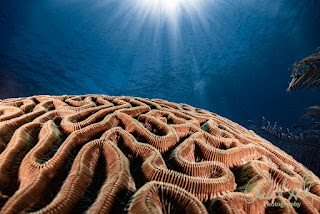A Comprehensive Dive into the Future of Underwater Photography
In the ever-evolving realm of photography, the underwater domain stands out as a challenging yet mesmerizing frontier. From the cumbersome equipment of yesteryears to the current era of sleek and technologically advanced gear, the trajectory of underwater photography has been nothing short of revolutionary. This blog delves into the future of underwater photography, examining the pivotal roles played by Artificial Intelligence (AI), camera and lens advancements, the impact of mirrorless cameras and smartphone camera technologies, and the cutting-edge tools available for photo processing.
- Artificial Intelligence (AI): Revolutionizing Underwater Imaging
As we plunge into the future, Artificial Intelligence (AI) is poised to be a game-changer in underwater photography. AI algorithms can now address the challenges of underwater environments, from color correction to noise reduction. This improves image quality and simplifies capturing underwater scenes.
Intelligent autofocus systems driven by AI are transforming the speed and accuracy of underwater photography. The ability to quickly and precisely focus on subjects allows photographers to seize fleeting moments, encouraging a more dynamic and creative approach to composition. The integration of AI into underwater photography workflows is expected to push the boundaries creatively and technically.
- Camera and Lens Advancements: Precision and Durability Below the Surface
The future of underwater photography relies heavily on specialized equipment designed to endure the demanding conditions of aquatic environments. Camera and lens advancements are at the forefront of this evolution. Manufacturers are investing in technology that improves the image quality, durability, and reliability of underwater gear.
Innovations in lens coatings, autofocus systems, and low-light performance are equipping photographers with tools tailored to the challenges of underwater shooting. Sensors with improved dynamic range and sensitivity are facilitating better performance in low-light conditions, capturing the intricate details and vibrant colors of marine life with unparalleled precision.
- The Impact of Mirrorless Cameras and Smartphone Camera Technologies: Changing the Landscape of Accessibility
Mirrorless cameras are making waves in the underwater photography community by offering a more compact and lightweight alternative to traditional DSLRs. The absence of a mirror mechanism allows for smaller and more portable camera bodies, making them well-suited for underwater use. Furthermore, advancements in mirrorless camera technology, such as faster autofocus and superior image stabilization, are empowering photographers to capture sharp and steady shots in dynamic underwater environments.
Smartphone camera technologies are evolving rapidly, making underwater photography accessible to more people. With the increasing availability of waterproof smartphone cases and accessories, both professionals and enthusiasts can capture stunning underwater photos without investing in specialized equipment. These accessories provide an affordable and convenient way to explore the depths of the ocean, lakes, and rivers, while keeping your phone safe and dry. Whether you are a seasoned photographer or a beginner, these waterproof phone cases and accessories make underwater photography an exciting and accessible activity for everyone. The accessibility and convenience of smartphone cameras are broadening the community of underwater photographers and fostering a deeper appreciation for the mesmerizing beauty beneath the waves.
- Photo Processing Tools: Navigating the Depths of Creativity with Precision
In the post-processing realm, underwater photography is benefiting from a surge in advanced tools tailored to the unique challenges faced below the surface. Specialized software solutions are emerging with features designed to correct underwater color casts, enhance contrast, and reduce backscatter – those unwanted specks caused by suspended particles in the water.
HDR (High Dynamic Range) processing has become a staple for underwater photographers, enabling them to capture and showcase the full spectrum of colors in challenging lighting conditions. Additionally, the infusion of machine learning into photo processing tools is streamlining workflows, allowing photographers to automate repetitive tasks and achieve consistent, professional results with greater ease.
- Environmental Considerations: Preserving the Underwater World
As the future of underwater photography unfolds, there is a growing recognition of the need for responsible and sustainable practices. Photographers are increasingly mindful of their impact on the delicate ecosystems they capture, emphasizing ethical and environmentally conscious approaches to their craft.
Underwater photographers are becoming advocates for marine conservation, using their images to raise awareness about the importance of preserving underwater biodiversity. The integration of AI in image recognition is also aiding conservation efforts by enabling photographers to document and monitor changes in marine life over time, contributing valuable data for scientific research.
In the coming years, we can expect a continued emphasis on ethical practices and a heightened awareness of the role photographers play in safeguarding the underwater world. As technology advances, tools that facilitate sustainable underwater photography are likely to become more prevalent, ensuring that future generations can continue to explore and appreciate the beauty of our oceans.
- Immersive Technologies: Virtual Reality and Beyond
The future of underwater photography is not limited to still images. Immersive technologies, such as virtual reality (VR) and augmented reality (AR), are emerging as powerful tools to enhance the underwater photography experience. VR allows viewers to dive into a virtual underwater world, providing a more immersive and interactive way to explore marine environments.
Underwater photographers are experimenting with 360-degree cameras and VR applications, enabling users to experience the depths from the comfort of their homes. This not only broadens the reach of underwater photography but also fosters a deeper connection between the audience and the underwater realm.
As these immersive technologies continue to evolve, we can anticipate new storytelling possibilities and educational opportunities in the realm of underwater photography, further bridging the gap between the underwater world and those who may never physically venture into its depths.
- Collaboration and Community Building: A Rising Tide Lifts All Boats
The future of underwater photography is not only about technological advancements but also about fostering a sense of community among photographers. Online platforms, social media groups, and underwater photography communities are becoming hubs for sharing knowledge, experiences, and breathtaking images.
Collaboration between photographers, scientists, and conservationists is increasing, resulting in unique projects that merge art with science. These partnerships not only enhance the field of underwater photography but also provide a better grasp of the marine environment and the difficulties it encounters.
As the community continues to grow, mentorship programs and workshops are likely to become more prevalent, providing aspiring underwater photographers with the guidance and support needed to navigate the complexities of this specialized niche.
Conclusion:
The future of underwater photography is a dynamic tapestry
woven with technological advancements, environmental consciousness, immersive
experiences, and a thriving community of enthusiasts. As we dive deeper into
the 21st century, the possibilities for capturing the mysteries and wonders
beneath the waves are expanding at an unprecedented pace. From AI-driven
enhancements to the preservation of marine ecosystems, the journey into the
future promises to be an exhilarating exploration of creativity, responsibility,
and the boundless beauty of the underwater world. As photographers continue to
push the limits of innovation and collaboration, the future of underwater
photography remains a thrilling adventure waiting to be captured, shared, and
cherished.
I am eagerly anticipating your valuable feedback and suggestions.
Sincerely,
Bob Herb
|
|





Comments
Post a Comment
Please let me know your comments.